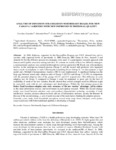Please use this identifier to cite or link to this item:
http://www.alice.cnptia.embrapa.br/alice/handle/doc/902925| Title: | Analysis of difussion strategies in northeast Brazil for new cassava varieties with new improved nutritional quality. |
| Authors: | GONZALEZ, C.  PÉREZ, S.   CARDOSO, C. E. L.   ANDRADE, R.   JOHNSON, N.   |
| Affiliation: | CAROLINA GONZALEZ, CIAT-IFPRI; SALOMÓN PÉREZ, CIAT; CARLOS ESTEVAO LEITE CARDOSO, CNPMF; ROBERT ANDRADE, CIAT; NANCY JOHNSON, ILRI. |
| Date Issued: | 2011 |
| Citation: | In: REUNIÃO DE BIOFORTIFICAÇÃO NO BRASIL, 4., 2011. Teresina. Palestras e resumos... Rio de Janeiro: Embrapa Agroindústria de Alimentos; Teresina: Embrapa Meio-Norte, 2011. 1 CD-ROM. Coordenadores: Marília Regini Nutti, Maurisrael de Moura Rocha. |
| Pages: | 4 p. |
| Description: | In 2006, Embrapa, supported by the HarvestPlus Program and CIAT released four yellow varieties with improved levels of provitamin A: BRS Dourada, BRS Gema de Ovo, Amarelo I and Amarelo II. For the diffusion process two strategies were used: 1) a participatory research approach with farmers and 2) public awareness raising activities. To evaluate the results of these two diffusion strategies, a socioeconomic analysis was carried out through two surveys applied in NE Brazil, one with producers involve in the participatory research process (Group 1) and the second with producers who requested stakes (seed) via telephone or mail, following the Launching Event (Group 2). For data analysis, a logit model and a Multiple Correspondence Analysis (MCA) were implemented. A significant finding was the large gap between actual early adoption rates of Group 1 (62.5%) and Group 2 (15.0%) in comparison with the potential adoption rates of the groups (62.1% and 64% respectively). This difference in early adoption rate for Group 2, compared to Groups 1 could be explained, in great part, by the lack of availability of seeds of the new varieties. Results showed that several strategies used for diffusion might be successful, each with its own advantages and disadvantages. Within the first strategy process the factors found to enhance adoption rates were: awareness of the new varieties? advantages; public entities as the main information sources; and involvement in participatory research. Within the second strategy trends were found between adoption rates and producer characteristics including: ownership of land; middle-level income; advance education level; and use of information mediums, namely the Internet. In the case of the second strategy, a lack of seeds was one of the main factors limiting the adoption process Currently a new study about household perceptions toward some crops (bean, chickpea, sweet potato, cassava and corn) with better nutritional qualities is developing in Sergipe. |
| Thesagro: | Mandioca |
| NAL Thesaurus: | cassava |
| Type of Material: | Artigo em anais e proceedings |
| Access: | openAccess |
| Appears in Collections: | Artigo em anais de congresso (CNPMF)  |
Files in This Item:
| File | Description | Size | Format | |
|---|---|---|---|---|
| ANALYSISCarlosEstevao.pdf | 186,05 kB | Adobe PDF |  View/Open |









